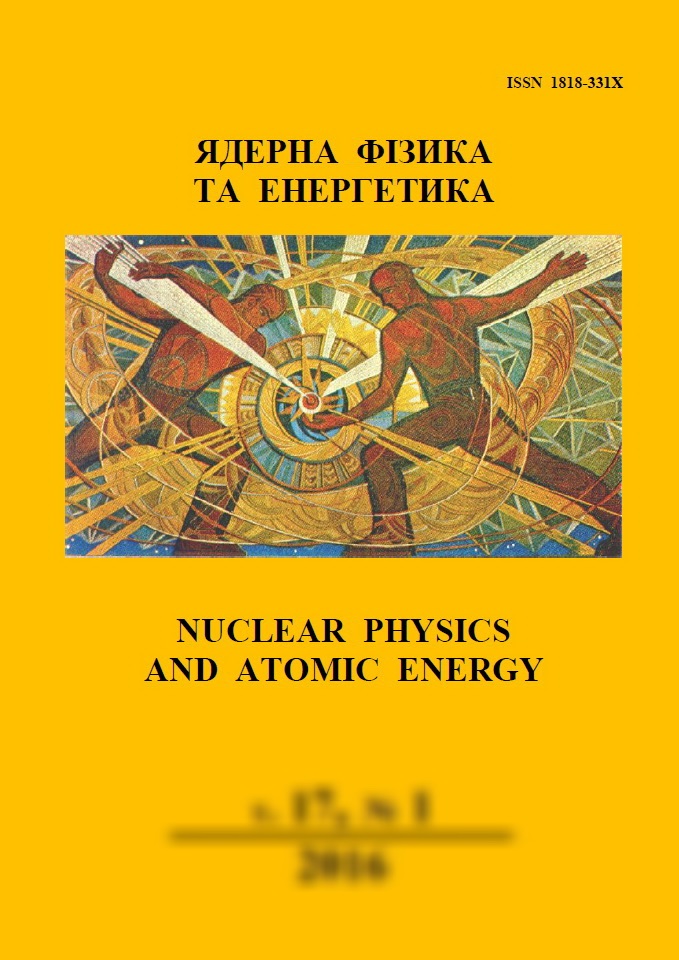 |
ßäåðíà ô³çèêà òà åíåðãåòèêà
Nuclear Physics and Atomic Energy
ISSN:
1818-331X (Print), 2074-0565 (Online)
Publisher:
Institute for Nuclear Research of the National Academy of Sciences of Ukraine
Languages:
Ukrainian, English
Periodicity:
4 times per year
Open access peer reviewed journal
|
Nucl. Phys. At. Energy 2025, volume 26, issue 2, pages 130-138.
Section: Nuclear Physics.
Received: 17.02.2025; Accepted: 24.05.2025; Published online: 24.06.2025.
 Full text (ua)
Full text (ua)
https://doi.org/10.15407/jnpae2025.02.130
Interaction of protons with nuclei in the Born approximation (I)
Yu. A. Berezhnoy1, V. A. Zolotarev2, V. P. Mikhailyuk3,*
1 V. N. Karazin Kharkiv National University, Kharkiv, Ukraine
2 National Scientific Center “Kharkiv Institute of Physics and Technology”, National Academy of Sciences of Ukraine, Kharkiv, Ukraine
3 Institute for Nuclear Research, National Academy of Sciences of Ukraine, Kyiv, Ukraine
*Corresponding author. E-mail address:
mikhailyuk@kinr.kiev.ua
Abstract:
Based on the Born approximation an approach that allows studying the processes of particle-nucleus interaction in the intermediate energy region has been developed. In contrast to the approach, presented in our previous papers, where analytical expressions for polarization observables for elastic proton scattering by nuclei were obtained using the expansion of the potential into the series up to the first significant terms, in this approach, the decomposition of such potential was not used. When obtaining analytical expressions for the amplitudes for elastic scattering of protons by nuclei, the second Born approximation with a potential in the Woods - Saxon form, as well as with the potential with a sharp absorption boundary, which was corrected to take into account the blurring of the nuclear surface, are used.
Keywords:
Born approximation, polarization observables.
References:
1. Yu.A. Berezhnoy, V.P. Mikhailyuk. Polarization of protons in the optical model. Chinese Phys. C 41(2) (2017) 024102.
https://doi.org/10.1088/1674-1137/41/2/024102
2. A.V. Babak, Yu.A. Berezhnoy, V.P. Mikhailyuk. Born approximation for polarization observables at the scattering of protons by 40Ca nuclei. Ukr. J. Phys. 65(5) (2020) 369.
https://doi.org/10.15407/ujpe65.5.369
3. P.E. Hodgson. Nuclear Reactions and Nuclear Structure. (The International series of monographs on physics) (Oxford, Clarendon Press, 1971) 661 p.
Amazon books
4. P.E. Hodgson. The Nucleon Optical Model (World Scientific Publishing Co. Pte. Ltd., 1994) 432 p.
https://doi.org/10.1142/2317
5. H. Feshbach. A unified theory of nuclear reactions, II. Ann. Phys. 281 (2000) 519.
https://doi.org/10.1006/aphy.2000.6016
6. A.I. Akhiezer, Yu.A. Berezhnoy, V.V. Pilipenko. Nuclear Diffraction. I.M. Khalatnikov (Ed.) Ser. Phys. Rev. 18(3) (1997) 147 p.
7. Yu.A. Berezhnoi, V.P. Mikhailiuk, V.V. Pilipenko. Diffraction Nuclear Processes (Kyiv: Naukova Dumka, 2014) 258 p. (Rus)
8. W.E. Frahn. Wave mechanics of heavy ion collisions. In: Heavy-Ion, High Spin States and Nuclear Structure. Vol. 1. Proc. of the Int. Extended Seminar, Trieste, Italy, 17 Sep. - 21 Dec. 1973 (Vienna: International Atomic Energy Agency, 1975) p. 157.
https://www.iaea.org/publications/3155/heavy-ion-high-spin-states-and-nuclear-structure-trieste-17-sep-21-dec-1973
